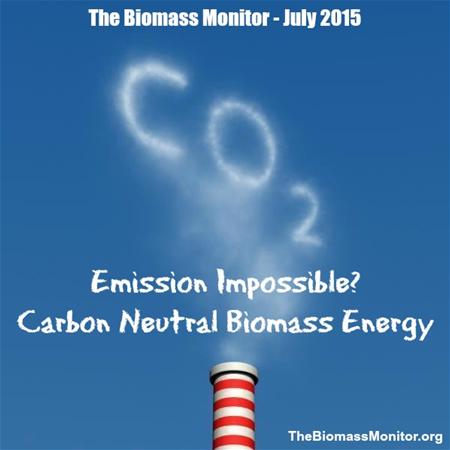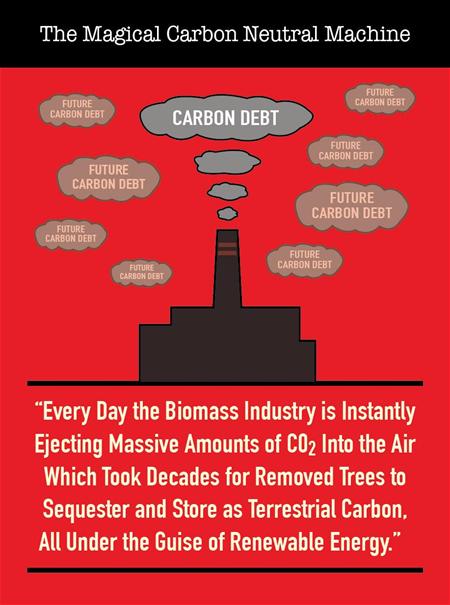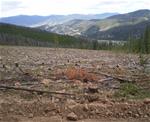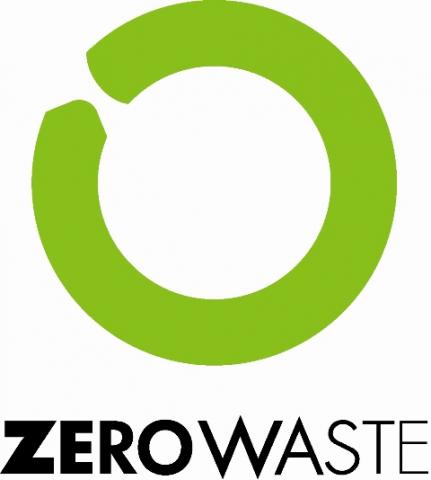| |
Emission Impossible? Carbon Neutral Biomass Energy
(July 2015)
Biomass Energy and the Carbon Neutral Shell Game
- by Brett Leuenberger, The Biomass Monitor
Who would have ever thought that clean renewable energy
could come from a smokestack? And yet, according to our U.S. government
and the biomass industry, that's exactly what's happening when you burn
trees (biomass) for energy. I don't know about you, but when it comes to
renewable energy, I think of wind turbines and solar panels producing
clean, emission-free renewable energy.

While
the final rulemaking process for biomass emissions is still in review,
the U.S. Environmental Protection Agency (EPA) released this
memo last November from Janet McCabe to industry stakeholders, which endorses
most biomass emissions as carbon neutral:
"For waste-derived
feedstocks, the EPA intends to propose exempting biogenic CO2 emissions
from GHG BACT analyses and anticipates basing that proposal on the
rationale that those emissions are likely to have minimal or no net
atmospheric contributions of biogenic CO2 emissions, or even reduce such
impacts, when compared with an alternate fate of disposal."
Most
of us can agree with the fact that we're facing unprecedented global
climate change due to our use of fuels that emit greenhouse gases
(mainly carbon) into the atmosphere. There are a few possible ways to
address this global climate challenge. One way is to vastly reduce or
terminate our use of carbon emitting fuel sources by transitioning to
emission-free energy sources like wind, solar and tidal. We could expand
on that idea by creating hyper-local communities that focus on energy
efficiency and renewable energy through the use of micro-grids. That's
why the carbon emissions from biomass are so critically important,
especially as we look to our future energy and transportation needs and
how those choices affect our earth's climate.
READ MORE

White House Rejects Biomass Energy as Carbon Neutral
- by Executive Office of the President of the United States
The
Administration strongly opposes House passage of H.R. 2822, making
appropriations for the Department of the Interior, Environment, and
related agencies for the fiscal year ending September 30, 2016, and for
other purposes.
The
bill drastically underfunds core Department of the Interior programs as
well as the Environmental Protection Agency's operating budget, which
supports nationwide protection of human health and our vital air, water
and land resources.
They
would make it harder for States and businesses to plan and execute
changes that would decrease carbon pollution and address the challenges
the Nation faces from climate change.
Classification of Forest Biomass Fuels as Carbon-Neutral
The
Administration objects to the bill's representation of forest biomass
as categorically "carbon-neutral." This language conflicts with existing
EPA policies on biogenic CO2 and interferes with the position of States
that do not
apply the same policies to forest biomass as other renewable
fuels like solar or wind. This language stands in contradiction to a
wide-ranging consensus on policies and best available science from EPA's
own independent Science Advisory Board, numerous technical studies,
many States, and various other stakeholders.
READ MORE

Red Rock Biofuel Will Not Be Carbon Neutral
- by Northwest Environmental Defense Center
Below are excerpted comments from Northwest
Environmental Defense Center and other groups and individuals opposed to
the construction of a biofuel facility in Lakeview, Oregon by Red Rock
Biofuel.
Red
Rock's proposed facility will not be carbon neutral. Indeed, the
facility will emit over 270,000 tons per year of greenhouse gases
(GHGs). The fact that Red Rock proposes to use woody biomass or LNG as
feedstock should not create a discount for these emissions. "The physics
of the greenhouse effect is indifferent as to the origin of the
pollutant." Gunn JS, Ganz DJ, and Keeton WS (2012) Biogenic vs. geologic
carbon emissions and forest biomass energy production. "[W]hat matters
is the amount of CO2 in the atmosphere, regardless of the source."
The federal government is "encourag[ing] the development and
use of alternative fuels to reduce greenhouse gas emissions associated
with aviation and to enhance economic development and energy security
for the United States," including "actively supporting alternative jet
fuels." U.S. Government Accountability Office, Alternative Jet Fuels
(May 2014). That same U.S. Government Accountability Office report also
notes that "[t]here is no globally agreed-upon approach, however, for
determining the greenhouse gas effects of renewable fuels and the
magnitude of any greenhouse gas reductions attributable to their
production and use."
In fact, switching from fossil fuels to wood energy could
actually result in increased levels of atmospheric GHGs over a period of
decades.
Given the threats to public health and the environment posed
by GHG emissions, Oregon's policy of addressing climate change, and
growing concerns about the impacts of climate change on global warming,
DEQ must deny this request for an air permit that will add a major new
source of GHG emissions in the state.
The Biomass Monitor is
the nation's leading publication covering the health and environmental
impacts of "biomass" energy. We accept submissions at thebiomassmonitor
AT gmail.com.
Graphics: Brett Leuenberger
Sincerely,
Josh Schlossberg, Mike Ewall, and Samantha Chirillo
Editors, The Biomass Monitor
For subscriptions, blog, and back issues go to: thebiomassmonitor.org
|
|
|

FROM THE EDITOR
- by Josh Schlossberg, Editor
A
major reason behind taxpayer subsidies for "renewable" energy is to
reduce carbon dioxide emissions, in hopes of preventing the worst of
runaway climate change.
Currently, there's only one form of energy subsidized as
"renewable" that results in direct carbon emissions into the atmosphere,
from not just the construction of the facility, but the energy source
itself. And that's bioenergy.
Forests, plants, and other living materials sequester and
store carbon, acting as one of the world's most effective (and free)
buffers against climate change. When we convert these living organisms
into energy, an immediate pulse of carbon dioxide is released into the
atmosphere. While some studies conclude that this carbon will be
re-sequestered within decades to centuries, others demonstrate a
permanent increase in atmospheric CO2.
Even the best-case scenario of a few decades doesn't jive
with the insistence of climate scientists that we cut our emissions now,
that any reductions in the future will be too little, too late.
Recently, the White House made a statement refuting that
forest biomass energy be "categorically" classified as carbon neutral.
Now, this doesn't mean they don't think that some forms of biomass
energy are, simply that they disagree with classifying all biomass that
way.
It's very easy for those working on the issue to argue
forever about which kinds of biomass should be considered carbon neutral
and which should not. However, there's only one way to accurately
account for the actual contributions of bioenergy to climate change, and
that includes measuring the carbon dioxide emitted from facility
smokestacks.

BIOMASS BREAKDOWN
Top 10 Biomass Stories in the News
Follow The Biomass Monitor on Facebook and Twitter for breaking news on biomass energy.
1. Air Pollution World's Top Environmental Health Risk
2. Wisconsin Biomass Facility Offline for 6 Months
3. Oregon Declares Biomass Carbon Neutral
4. Louisville, KY Councilor: We Won't Let Biofuel Facility Be Built
5. Duke Energy to Burn Swine Waste in Natural Gas Facilities, Call it Renewable
6. Minnesota Biofuels Facility Closed After Explosion; Two Injured
7. Residential Heating and Biomass Power Consumed Nearly Same Amount of BTU in 2013
8. Orangetown, NY Holds Hearing to Prohibit Biomass Gasification and Biochemicals
9. Ohio Incinerator Operator to Pay $34,000 for Ash Malfunction
10. Dozens Injured in Chinese Protest Against Trash Incinerator

CONFERENCE CALL
Is Biomass and Trash Incineration Zero Waste?
Should burning materials that can be recycled or composted
count as Zero Waste? The "waste-to-energy" industry claims incineration
is compatible, while the Zero Waste International Alliance says no. What
do you think?
Join
The Biomass Monitor on Thursday, July 16 at 5 pm PT (8 ET) where we
speak with Ananda Tan, of Global Alliance for Incinerator Alternatives
(GAIA), and Mike Ewall, director of Energy Justice Network, to get the
counterpoint to industry claims on Zero Waste and incineration.
RSVP by emailing thebiomassmonitor at gmail.com for call in number.
Calls are 3rd Thursdays of each month.
Download the audio file for June's call, "Honoring the Environmental Movement's Fallen Heroes."
|
|





